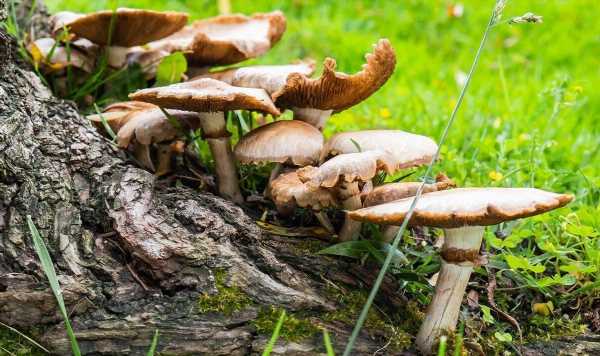
‘May look harmless’ – ‘key signs’ the mushrooms in your lawn are toxic
10/31/2022Kelly Brook picks 'edible and delicious' mushrooms
We use your sign-up to provide content in ways you’ve consented to and to improve our understanding of you. This may include adverts from us and 3rd parties based on our understanding. You can unsubscribe at any time. More info
Lawn mushrooms are easy to ignore in small amounts but they can quickly multiply given the right conditions. While preventing fungi from growing in the garden is almost impossible to do in the colder months, gardening experts have urged Britons to take steps to remove toxic varieties as soon as they appear. But how do you know what to look for? Express.co.uk spoke to Jack Sutcliffe, co-founder of Power Sheds and Holly Garrad-Cole, food expert at finedininglovers.com to find out.
Mushrooms can be dangerous because they can contain toxins. These toxins are, generally speaking, to protect themselves against predators but they can be fatal if ingested by humans.
Speaking exclusively to Express.co.uk, Jack said: “From September to November, it’s mushroom season in the UK and with so many different types, it’s hard to know what is safe to have in your garden.
“Even if they look safe, we wouldn’t advise eating mushrooms from your garden unless you know exactly what it is and that it is not toxic. “If they are poisonous and you have pets, it’s important to remove them to be safe.”
While there are more than 10,000 different types of mushrooms across the world, Jack explained that there are four main varieties which are “most common” in gardens across the country.


Fly agaric
He said: “Whilst this mushroom may look cute and harmless, fly agarics are poisonous and should not be eaten. “Reports of death from eating them are very rare but they also cause stomach cramps, hallucinations and psychosis.”
The easiest way to identify fly agaric mushrooms is to look out for their scarlet-orange tones and wart-like spots. According to Jack, these mushrooms grow to around 30cm tall and have a long history of being used in religious ceremonies.
Fool’s funnel
Also known as the “sweating mushroom”, fool’s funnel is often easiest to spot in lawns and grassy areas across the UK. Jack noted that this type of fungus has a long growing period, between July and December.
DON’T MISS
‘Biggest reason’ mice enter homes – ‘effective’ methods to deter them [EXPERT]
‘Permanently kill weeds’ using three ‘everyday household items’ [TIPS]
I tried the white vinegar and newspaper hack to clean my windows [INSIGHT]
He said: “It contains a toxin known as muscarine which when eaten, can cause sickness, diarrhoea, blurred vision, excessive sweating and stomach pain, and can be fatal in large doses.”
Look out for large, flat mushrooms with a shallow dip in the centre and a tall white stem.
Field mushroom
Perhaps the most common variety found in the UK, field mushrooms are frequently spotted in green spaces and gardens.
They are around 5-10cm in length and have a white stem. According to Jack, these are non-toxic, though Holly Garrad-Cole, a Food expert at finedininglovers.com recommended speaking to a local foraging professional to double check your findings.


She added: ” Over 250 species of edible mushrooms are known of in the West and there are also at least as many toxic varieties.
“Check what you have found against as much literature as you can before picking, there are some great apps too but don’t rely on this only. Always have your mushrooms checked by a professional.”
Shaggy inkcap
Unlike other varieties, shaggy inkcap has a more distinctive appearance and is easier to tell apart from other fungi. Jack said: “This mushroom is tall and white with a shaggy cap, hence the name. It’s also known as a lawyer’s wig or shaggy mane.
“They are fairly common in gardens and parklands across the UK, growing in small groups. They’re edible and said to be tasty, appearing most often after it’s been raining.”

How to remove poisonous mushrooms
Just like flower seeds, mushrooms serve to reproduce a fungus and ensure its survival.
However, instead of spreading seeds, fungi have microscopic spores on their gills and under the cap that either blow with the wind or travel with bugs that eat them – making them incredibly hard to keep under control.
While picking lawn mushrooms is often a waste of time before they grow back again, it is necessary for poisonous varieties. To lift them from the lawn, home advice expert Bob Vila recommended using a knife.
Wearing gloves, cut each stem and dispose of the mushrooms in garden waste. Avoid throwing the fungi into your compost heap as this will encourage the spores to grow elsewhere in your lawn.
Source: Read Full Article

